Contents
Hyperhidrosis of the feet is excessive sweating on the soles of the feet. The process of excessive sweating is characterized by an unpleasant odor, frequent dermatological infections and itching. Therefore, despite the fact that hyperhidrosis is not recognized as a disease by official medicine, this pathology gives a person severe discomfort. To get rid of hyperhidrosis, it is necessary to find out the causes of its occurrence and only then try to eliminate them.
Symptoms of foot hyperhidrosis
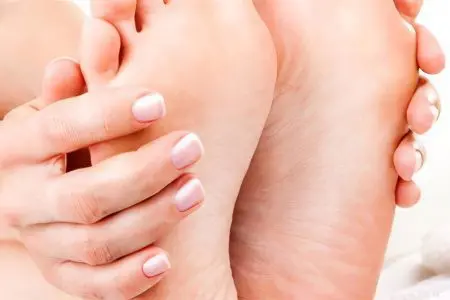
Hyperhidrosis of the feet is expressed in increased sweating, which occurs for no apparent reason. That is, the feet remain moist when the person is at rest, has no visible symptoms of the disease, and the ambient temperature is not elevated. Socks, stockings, tights – all these items of clothing are constantly wet and require changing several times a day. The same goes for shoes.
Another obvious symptom of hyperhidrosis of the feet is an unpleasant odor that comes from the feet. Moreover, it is not possible to cope with it with the help of regular hygiene measures. The use of auxiliary means (deodorants, aromatic pads, etc.) gives only a temporary effect.
Foot hyperhidrosis is often accompanied by fungal infections. Increased humidity in the foot area and the “greenhouse effect” created in shoes is a favorable environment for the reproduction of mycotic microorganisms. Therefore, the fight against persistent fungal infections of the foot becomes part of the life of a person with hyperhidrosis. Signs of a fungal infection are itching and burning of the skin of the feet and the skin between the toes, peeling and redness of the dermis.
The following signs will indicate the psychogenic nature of foot hyperhidrosis:
Sudden onset of hyperhidrosis, which does not depend on the person’s age.
Before sweating began to manifest itself clearly, a person could suffer psychological trauma.
During a night’s rest, sweating decreases.
The disease has a relapsing course and worsens after emotional excitement.
The feet, palms, and armpits sweat the most.
When foot hyperhidrosis is a consequence of disorders in the functioning of the autonomic nervous system, this is accompanied by the following symptoms:
Extremities cold and wet.
The skin is pale.
Sleep is restless.
A person does not tolerate bright light, heat, and the intake of drinks containing caffeine.
There is a tremor of the limbs, chilliness.
Primary (idiopathic) hyperhidrosis will be indicated by the following symptoms:
Early manifestation of the disease (in childhood or adolescence).
The presence of a similar pathology in a blood relative (not a prerequisite).
With emotional excitement, sweating does not increase.
Sweat most often feet, palms and armpits.
During a night’s rest, sweating does not increase.
In general, there are no other pathological symptoms.
With endocrine hyperthyroidism, sweating increases at night and in the evening. There is no connection with nervous strain.
Causes of foot hyperhidrosis
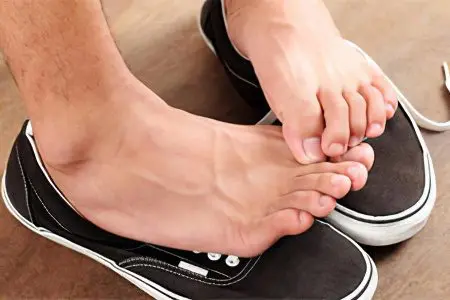
True hyperhidrosis of the feet should be distinguished from banal sweating and violations of personal hygiene rules. Sweat is a natural process of thermoregulation of the body. Thus, he tries to solve the problem of heat transfer during overheating, during waves or other factors.
Therefore, do not worry if the sweating of the legs increases for the following reasons:
Prolonged time in shoes.
Wearing clothes or shoes made of poor quality materials.
Wearing shoes that don’t fit.
Violations of the rules of foot skin care.
Violation of thermoregulation in the body: its overheating while in a room with high air temperature, during active physical exertion, etc.
All these factors create favorable conditions for the development of foot hyperhidrosis, but it is enough to eliminate them, and the problem will be solved by itself. No specific treatment is required.
As for the pathological causes of foot hyperhidrosis, the following can be noted among them:
Psychogenic hyperhidrosis of the feet. Sweating increases as a result of exposure to stressful situations on the body, or against the background of a strong emotional shock. Moreover, after the elimination of the influencing factor, hyperhidrosis does not go away, but only subsides a little. With the onset of the next episode of emotional excitement, sweating intensifies again. The danger is neurosis, asthenia, insomnia, etc.
Idiopathic hyperhidrosis, which is characterized by excessive sweating of the feet, hands, and armpits. This form of hyperhidrosis is caused by increased excitability of the sympathetic division of the nervous system. Most often, this type of hyperhidrosis is inherited and can be traced in blood relatives. Manifests pathology in early childhood, intensifies in puberty. As the body ages, the symptoms of hyperhidrosis become less pronounced.
Endocrine hyperhidrosis, which develops against the background of pathology of the endocrine glands. If hyperhidrosis is a consequence of diabetes mellitus, obesity, hyperthyroidism and other disorders in the functioning of the endocrine glands, then not only the feet, but also other parts of the body (back, face, palms, armpits) will sweat.
Diseases of the heart and blood vessels during an exacerbation can lead to increased sweating of the feet.
Hyperhidrosis of the lower extremities can become a symptom of oncological diseases, infectious processes occurring in the body. And we are talking not only about colds, but also about more serious pathologies, for example, syphilis, tuberculosis, hepatitis, HIV infection.
Diagnostics
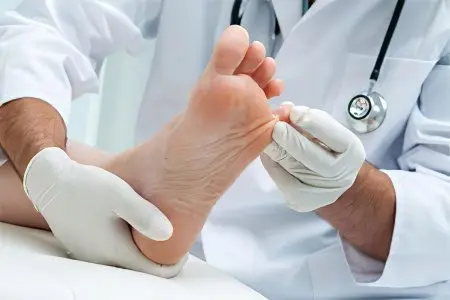
Diagnosis of foot hyperhidrosis is not difficult. It is much more difficult to determine the reason why this violation of thermoregulation occurs. A visit to the doctor’s office begins with a patient interview. The doctor will definitely find out how long a person has been worried about this problem, whether any of the family members are suffering from hyperhidrosis. To identify the cause of hyperhidrosis, the following tests are required:
Blood donation for general and biochemical analysis.
Blood donation for thyroid hormones.
Donating blood for hepatitis, HIV, latent sexual infections.
Blood donation to determine the level of glucose in the blood.
Urine for general analysis.
Based on the results of these studies, it will be possible to assume the nature of hyperhidrosis and prescribe a quality treatment to a person. It is possible that consultation of narrow specialists (endocrinologist, neurologist, psychotherapist, etc.) will be required.
If all indicators are within the normal range, then this indicates the idiopathic nature of foot hyperhidrosis.
Treatment of foot hyperhidrosis
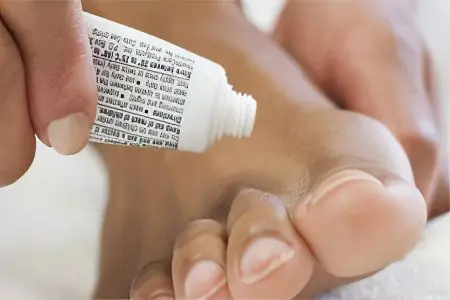
Treatment for hyperhidrosis of the feet depends on what exactly caused the excessive sweating. If the trigger is any disease (tuberculosis, hyperthyroidism, diabetes mellitus, etc.), then all efforts should be directed to its elimination.
Treatment of hyperhidrosis of the feet is reduced to the following recommendations:
Application of Teymurov’s paste on the feet. It is lubricated with a clean and dry skin of the legs with a thick layer. This will allow you to forget about sweating and unpleasant odors for up to 7 days.
Use of zinc ointment. This drug helps to normalize the work of the sweat glands. The ointment allows you to cope with mild hyperhidrosis of the feet. Apply the product on clean skin of the legs three times a day for a month.
The use of an alcohol solution of Formidron. This is an effective remedy for reducing sweaty feet and getting rid of unpleasant odors. A single use of the drug will achieve an effect for up to 2 weeks.
Subcutaneous injections of Botox or Dysport. The procedure is carried out in a cosmetology room. A certain dose of the drug is injected into the subcutaneous tissue in the region of the sweat glands, which contributes to the cessation of their functioning. The effect persists for 6 months. Then the processing will need to be repeated.
A physiological procedure such as iontophoresis has a good effect. The feet are affected by electrical impulses, which allows the drugs dissolved in water to penetrate deeper into the skin and have a therapeutic effect. This procedure allows you to reduce sweating for a period of 1 to 3 months.
Drug correction can be aimed at stabilizing the functioning of the nervous system. The doctor may prescribe drugs such as: Amitriptyline, Belloid, Clonazepam, etc.
The use of deodorants and antiperspirants allows for a short period of time to reduce sweating of the feet and get rid of the smell of sweat. Their duration varies from several hours to several days. These can be such products as: DEO control, spray “42”, antiperspirant “Maxim”, “Dry Dry”, “Klima” 15%. Before using them, you should consult your doctor.
You can use natural foot powders, including: starch, talc, baby powder. These substances absorb excess moisture and reduce the smell of sweat.
At home, you can make baths with medicinal herbs. Allows you to reduce sweating of the feet and muffle the unpleasant smell of decoction of oak bark, willow bark, sage, chamomile. To provide an antiseptic effect, you can use a solution of soda or potassium permanganate.
If conservative methods of treatment do not help to get rid of sweating of the legs, then they resort to surgical intervention. This procedure is called a sympathectomy. During the operation, the nerve sympathetic trunks, which are located in the lumbar region, are clamped. The fibers of the nervous tissue are destroyed, so the signal about the need for sweating will no longer be transmitted. It should be noted that this procedure is associated with the risk of complications. In particular, the body may start looking for alternative exit routes for sweat, so hyperhidrosis may occur elsewhere.
Exercises for foot hyperhidrosis
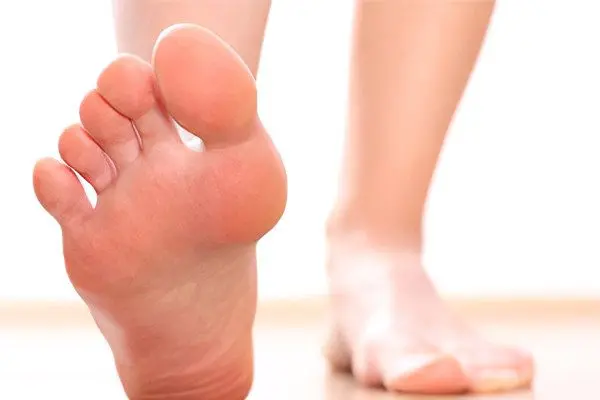
Gymnastics for hyperhidrosis of the feet is one of the methods of dealing with pathology at home. Its action is aimed at increasing blood circulation in the lower extremities, which will make it possible to normalize the work of the sweat glands.
To achieve a positive effect, you need to perform the following exercises (10 times each):
Walking barefoot on the outer and inner surface of the foot, on the toes.
Scrolling the feet clockwise and counterclockwise.
Rolling the ball with your toes from a sitting position.
Grabbing a flat object, such as a pencil, with your toes.
Squats on the right and on the left leg.
Gymnastics does not take more than 10 minutes a day, but the effect of it can exceed all expectations.
Prevention
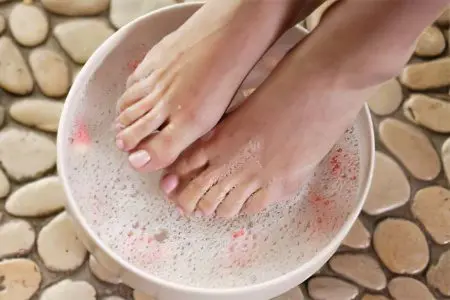
To prevent the development of foot hyperhidrosis, the following recommendations should be followed:
Socks, stockings and tights should be made exclusively from natural fabrics. They are better breathable and absorb moisture.
Shoes should be chosen from breathable materials. In the summer, preference should be given to open shoes.
Wash your feet with warm water at least 2 times a day. You can reduce sweating by taking contrast baths.
It is imperative to deal with flat feet. Healthy feet are less susceptible to various diseases.
Baths and lotions with decoctions of medicinal herbs allow you to stop the reproduction of bacteria and fungi, and therefore get rid of an unpleasant odor.
Chronic and acute diseases that can lead to hyperhidrosis should be treated in a timely manner.
The stability of the nervous system and a calm psychological background makes it possible to prevent the development of psychogenic hyperhidrosis.









